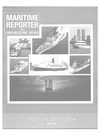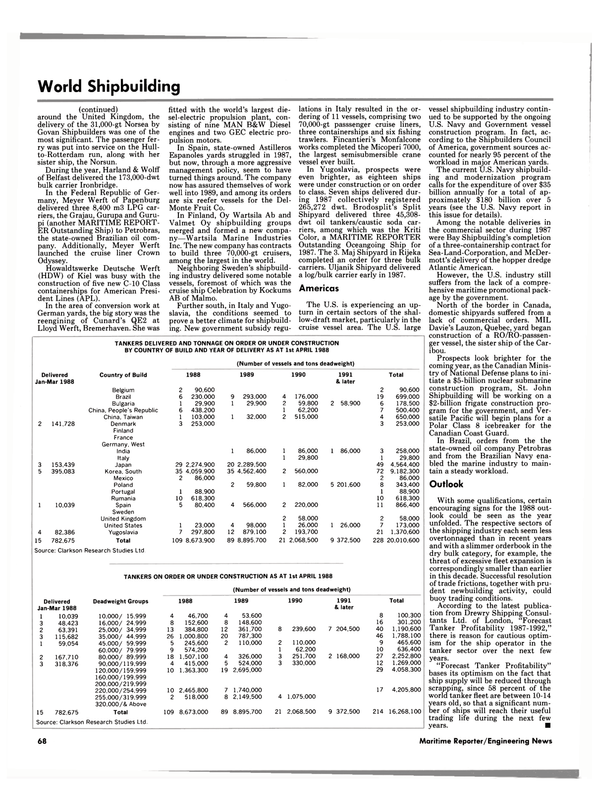
REVIEW AND OUTLOOK
Although 1987 was by no means a banner year for our shipbuilding, ship repairing and allied industries, it did have some positive aspects that portend well for the future. The Order Book total, i.e. vessels under construction and on order, at the end of 1987 was 63,820 GT, a 58% increase over 1986. While this tonnage is still far lower than the years before 1986, it is encouraging to note that 32,220 GT or just over half, stemmed from commercial contracts. It is certainly hoped that is indicative of future trends.
It is also encouraging that the number of foreign built vessels registered in Canada decreased slightly, from 9 to 7, although, in terms of gross tonnage, this represents a significant increase. Situations of this sort support the CMIA contention that, as Canada needs and wants a viable shipbuilding and repairing infrastructure, a national policy must be developed, to this end.
Such a policy should, we suggest, provide the capability for innovative financing arrangements to evolve, which would persuade Canadian fleet operators to build and refit in Canada. More about this later.
The value of allied industries marine revenue was down slightly from 1986, but the implications of the June, 1987 White Paper on Defence should reverse this trend during 1988.
During 1987, Marine Industries Limited acquired Versatile Vickers (Montreal), Versatile Davie (Lauzon) and Versatile Systems Engineering Inc. The MIL Group then consolidated the three shipyards along the St. Lawrence River, with respect to operations. This action undoubtedly warmed the cockles of the hearts of those members of the Federal bureaucracy intent on monitoring the rationalization of the Canadian shipyard infrastructure. At the time of writing, early May '88, it is understood that Government officials are involved in discussions on the West Coast but no results have yet been announced.
At the end of December, 1987 shipyard employment stood at 5,649, the lowest level in CMIA records. However reports have been received of significant hirings since the beginnings of '88.
During the first quarter of 1988, several new contracts were awarded, with a virtual 50-50 balance between new construction and refit/ repair.
The outlook through '88 into the next decade appears promising, for several reasons. First, world shipping increased steadily over the past 20 months, with several ports, including some in Canada, reporting record operations, either in certain categories of cargo, or in total. Secondly, Canadian fisheries are placing more orders in Canadian yards, not as many as we'd like, perhaps, but enough to provide work for several medium yards. Finally, offshore drilling continues at low levels in the Beaufort, off the Newfoundland coast and in the Sable Island area.
Planning is well advanced against the day when phasing into the production stages becomes economically viable, and this major move could be made in the near future.
Government contracting with respect to the Canadian Coast Guard and Fisheries & Oceans' fleets continues, with both new construction and major refit and repair contracts being expected this year. It is pending naval contracts, however, that are capturing media attention in all parts of the country. The third and fourth Tribal-Class modernizations have yet to be announced, and the industry anxiously awaits the Government's next move on the acquisition of a mine counter-measures fleet and other minor war vessels.
The nuclear-propelled submarine project, however, has gained the limelight. The "battle" between Britain and France to win the impending country-of-origin decision has progressed to the final rounds, and it is believed that this decision is imminent. In total, the prospects for shipbuilding and ship repairing in Canada, together with those for the allied manufacturing and service industries, hold promise for a modest recovery from the slump of the past few years.
Finally, the question of a national shipbuilding and repairing policy for Canada has advanced to a new stage. Working with Government officials, the CMIA has developed a framework for a national policy, which has now been submitted to the Prime Minister with a formal request that such a policy be formulated.
To use the somewhat trite expressions received from Government on this issue two years ago, the monkey is off the Association's back, and the ball is in the Government's court.
Read REVIEW AND OUTLOOK in Pdf, Flash or Html5 edition of June 1988 Maritime Reporter
Other stories from June 1988 issue
Content
- Castrol Offers Free 56-Page Lube Oil Guide & World Service Directory page: 6
- ODECO's Hugh J. Kelly Elected Chairman Of NOIA At 16th Annual Meeting page: 7
- $4.3 Million To Peterson Builders To Administer Navy Parts Acquisition page: 8
- John Kristen Joins Ingram Barge Company page: 10
- Service Marine Christens 600-Passenger Paddlewheeler For Heritage Cruise Lines page: 10
- World's Largest Railway/Freight Ferry Launched By Seebeckwerft page: 11
- NASSCO Announces Production Management Realignment page: 11
- SPD Technologies Negotiating To Acquire Navy Division Of Brown Boveri Power Equipment Inc. page: 11
- Munson Manufacturing Launches Alaskan Excursion Boat For Holland America-Westours page: 12
- MSC Awards Contracts Totaling $154.2 Million page: 14
- 1,000th Golar Marine Incinerator To Be Installed page: 14
- Skuld Undergoes Major Changes In Structure page: 15
- Report 'Genesis System' Can Produce Record Fuel Savings For Vessel Owners page: 16
- Bailey Controls Completes Installation Of N e w Flow Calibration Laboratory page: 16
- Houma Fabricators A w a r d e d Contract For Vehicle-Passenger Ferry page: 17
- Brochure Available On N e w Sound Absorption Material From Soundcoat page: 18
- John M. Stebbins Named VP, Sales And Marketing Of Alco Power Inc. page: 18
- Gladding-Hearn Receives Order For INCAT-Design Passenger Ferry For N e w York Commuter Service page: 20
- SPD Technologies Names Biancamano Manager, International Marketing page: 20
- Intertek Offers Free Eight-Page Full-Color Brochure On Services page: 21
- Blount Christens 'Spirit Of Chicago' —7th Luxury Dinner Vessel In 'Spirit' Line For Cruise International page: 22
- Marathon LeTourneau Introduces New GulfKing Class Jackup For Gulf Of Mexico page: 23
- THE $34-BILLION ANNUAL U.S. NAVY MARKET page: 24
- SHIPBUILDING AND REPAIR IN U.S. SHIPYARDS page: 40
- The Tug And Barge Industry Provides A Wealth Of Benefits To American Consumers page: 44
- BARGE INDUSTRY WAITS FOR CONGRESSIONAL ACTION ON HIGHWAY DIESEL TAX page: 44
- REVIEW AND OUTLOOK page: 62
- World Shipbuilding page: 64
- Cummins-Powered Paddlewheeler Delivered By Superior Boat Works page: 76
- Leslie Controls Announces DLO-1 Series 80 Valves page: 77
- Aeroquip Offers Hydraulic Troubleshooting Bulletin page: 77
- HDW Christens Two Containerships For American President Lines page: 78
- Bender Shipbuilding Delivers Fish Processing Vessel 'Seattle Enterprise' page: 78
- DEFCO Offers Free Literature On Diesel Products And Services page: 79
- Waugh Offers Literature On Head Modules And TNF Joiner Systems page: 79
- Electrocatalytic Acquires DEM Cell Technology page: 80
- McElroy Offers Free 47-Page Brochure On Deck Machinery page: 80
- Indicator Switch From Nupro Connects To Air Actuated Bellows Valves page: 81
- Spare Parts Amendment Passes House page: 81
- Shipyard 'Pride Program' Instituted At PSRY page: 82
- Ward Offers Brochure On Manufacture Of Marine Components page: 82
- Conrad Industries Delivers 650-Ton-Capacity Drydock To French West Indies page: 83
- Sensitive Regulator From Circle Seal Assures Accuracy For Corrosive Or Ultra-Pure Fluids page: 84
- Watercom Offers Extra Convenience Of Fax Machine Message Transmission page: 84
- Simrad Receives Canadian Contract page: 85
- Houston Ship Repair Busy With Work page: 86
- Stewart & Stevenson Expands Diesel Engine Sales/Service Network page: 88
- Sperry Marine Awarded Submarine Navigation Radar Contract page: 89
- Rexroth Introduces N ew Hydraulic Radial Piston Motor page: 89
- Trimble Introduces NavGraphic Loran Track Plotter, And New Digital Version Of 10X Loran page: 90
- Conrad Industries Sees Signs Of Optimism In Offshore Industry page: 90
- SPD Technologies Names Larry Colangelo Senior VP page: 91
- Moss Point Marine Delivers Second Of Four Army Landing Craft page: 92
- Bath Iron Works Launches Guided Missile Cruiser 'Normandy' page: 92
- PetroCom Completes First C e l l u l a r / S a t e l l i te Phone Service in Gulf Of Mexico page: 93
- Joseph Le Blanc Jr. Retires From Trinity Marine Group page: 93
- Derecktor Shipyard Lays Keel For First Of Two Tugboats For U.S. Army page: 94
- Wartsila Diesel Presents Paper At ASTM Symposium page: 94
- Hyde Offers Independent Power Unit Systems To Meet SOLAS Requirements page: 95
- SKF Introduces Keyless Bushing; Will Market Nilos Rings In U.S. page: 95
- McDermott Shipyard Delivers 1,475-Passenger Ferry page: 96
- M o n A r k ' s Workboat Division Delivers 28-Foot Patrol Boat page: 97
- Raytheon Marketing New Electromagnetic Speedlog Series page: 98
- Call For Papers For American Welding Society's 70th Annual Convention page: 99
- COMSAT A n d MCI Sign Interconnection Agreement page: 100
- N e w 138-Page Level And Flow Sensor Catalog O f f e r e d Free By GEMS page: 100
- Gems Offers 24-Page Catalog Featuring Continuous Liquid Level Indicating Systems page: 110
- Crew And Supply Boat Conversion Can Be A Profitable Venture page: 113
- Tom Bunyan, Inventor Of 'Pilgrim' Products Marketed By Mapeco, Honored By Queen Elizabeth page: 114
- Comsat Announces SafetyNet Service For Ships At Sea page: 115
- N e w Class DBOY-2 Valve Line N o w Available From Leslie Controls, Ltd. page: 115


